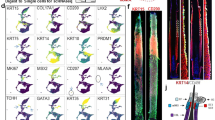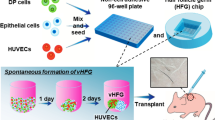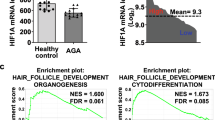Abstract
Hair morphology is one of the most differentiated traits among human populations. A previous study has shown that a nonsynonymous single nucleotide polymorphism (SNP) in the EDAR gene, EDAR 1540T/C, is strongly associated with hair thickness in Asian populations. However, the contributions of other genes remain to be elucidated. In this study, 12 SNPs on 10 hair formation-related genes with high differentiation between Asian and other populations were examined to further identify genes associated with hair morphology. A multiple regression analysis adjusted for age, sex, population and the effect of EDAR 1540T/C revealed an SNP in intron 9 of FGFR2, rs4752566, to be significantly associated with hair thickness (cross-sectional area; P-value=0.0052, small diameter; P-value=0.029 and large diameter; P-value=0.0015). In the genomic region containing the FGFR2 gene, rs4752566 was not in strong linkage disequilibrium (LD) with the surrounding SNPs, indicating that the significant association of rs4752566 with the hair thickness is not due to LD with polymorphisms of the other genes. The rs4752566-T allele of FGFR2, associated with thicker hair, was also shown to be associated with higher mRNA level of FGFR2 (P-value=0.0270). These results suggest that the FGFR2 polymorphism affects the variation in hair thickness in Asia through alteration in the expression level of FGFR2.
Similar content being viewed by others
Log in or create a free account to read this content
Gain free access to this article, as well as selected content from this journal and more on nature.com
or
References
Bean, R. B. Heredity of hair form among the Filipinos. Am. Nat. 45, 524 (1911).
Fujimoto, A., Kimura, R., Ohashi, J., Omi, K., Yuliwulandari, R., Batubara, L. et al. A scan for genetic determinants of human hair morphology: EDAR is associated with Asian hair thickness. Hum. Mol. Genet. 17, 835–843 (2008).
Fujimoto, A., Ohashi, J., Nishida, N., Miyagawa, T., Morishita, Y., Tsunoda, T. et al. A replication study confirmed the EDAR gene to be a major contributor to population differentiation regarding head hair thickness in Asia. Hum. Genet. 124, 179–185 (2008).
Carlson, C. S., Thomas, D. J., Eberle, M. A., Swanson, J. E., Livingston, R. J., Rieder, M. J. et al. Genomic regions exhibiting positive selection identified from dense genotype data. Genome. Res. 15, 1553–1565 (2005).
Voight, B. F., Kudaravalli, S., Wen, X. & Pritchard, J. K. A map of recent positive selection in the human genome. PLoS. Biol. 4, e72 (2006).
Kimura, R., Fujimoto, A., Tokunaga, K. & Ohashi, J. A practical genome scan for population-specific strong selective sweeps that have reached fixation. PLoS. ONE 2, e286 (2007).
Sabeti, P. C., Varilly, P., Fry, B., Lohmueller, J., Hostetter, E., Cotsapas, C. et al. Genome-wide detection and characterization of positive selection in human populations. Nature 449, 913–918 (2007).
Bryk, J., Hardouin, E., Pugach, I., Hughes, D., Strotmann, R., Stoneking, M. et al. Positive selection in East Asians for an EDAR allele that enhances NF-kappaB activation. PLoS ONE 3, e2209 (2008).
Barreiro, L. B., Laval, G., Quach, H., Patin, E. & Quintana-Murci, L. Natural selection has driven population differentiation in modern humans. Nat. Genet. 40, 340–345 (2008).
The International HapMap Consortium. A haplotype map of the human genome. Nature 437, 1299–1320 (2005).
Prodi, D. A., Pirastu, N., Maninchedda, G., Sassu, A., Picciau, A., Palmas, M. A. et al. EDA2R is associated with androgenetic alopecia. J. Invest. Dermatol. 128, 2268–2270 (2008).
Nishida, N., Tanabe, T., Takasu, M., Suyama, A. & Tokunaga, K. Further development of multiplex single nucleotide polymorphism typing method, the DigiTag2 assay. Anal. Biochem. 364, 78–85 (2007).
Stranger, B. E., Nica, A. C., Forrest, M. S., Dimas, A., Bird, C. P., Beazley, C. et al. Population genomics of human gene expression. Nat. Genet. 39, 1217–1224 (2007).
Petiot, A., Conti, F. J., Grose, R., Revest, J. M., Hodivala-Dilke, K. M., Dickson, C. et al. A crucial role for Fgfr2-IIIb signalling in epidermal development and hair follicle patterning. Development. 130, 5493–5501 (2003).
Schmidt-Ullrich, R. & Paus, R. Molecular principles of hair follicle induction and morphogenesis. Bioessays. 27, 247–261 (2005).
Yan, M., Wang, L. C., Hymowitz, S. G., Schilbach, S., Lee, J., Goddard, A. et al. Two-amino acid molecular switch in an epithelial morphogen that regulates binding to two distinct receptors. Science 290, 523–527 (2000).
Acknowledgements
We are deeply grateful to the people participating in this study. We thank two anonymous reviewers for valuable comments and suggestions on this article. This study was partly supported by a Grant-in-Aid for Scientific Research from the Ministry of Education, Culture, Sports, Science and Technology of Japan (to JO).
Author information
Authors and Affiliations
Corresponding author
Rights and permissions
About this article
Cite this article
Fujimoto, A., Nishida, N., Kimura, R. et al. FGFR2 is associated with hair thickness in Asian populations. J Hum Genet 54, 461–465 (2009). https://doi.org/10.1038/jhg.2009.61
Received:
Revised:
Accepted:
Published:
Issue date:
DOI: https://doi.org/10.1038/jhg.2009.61



